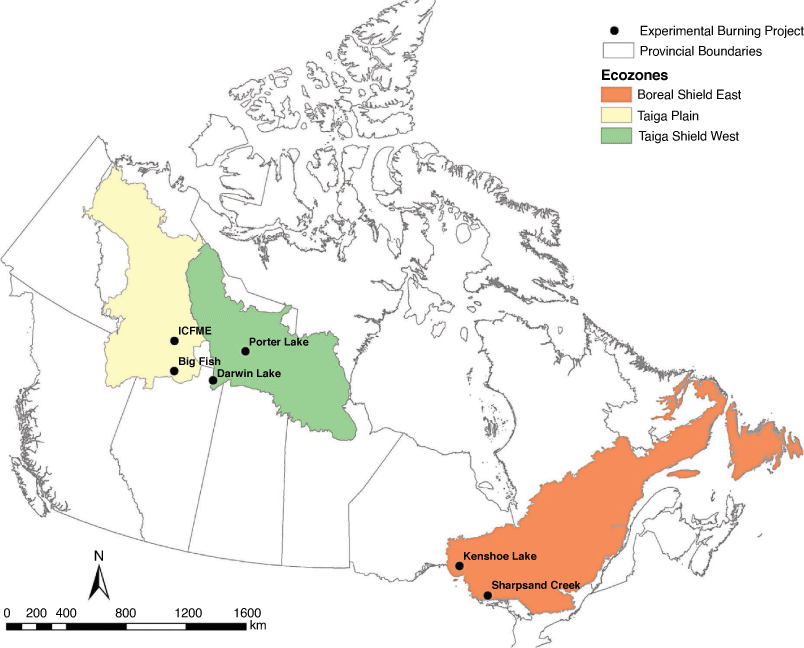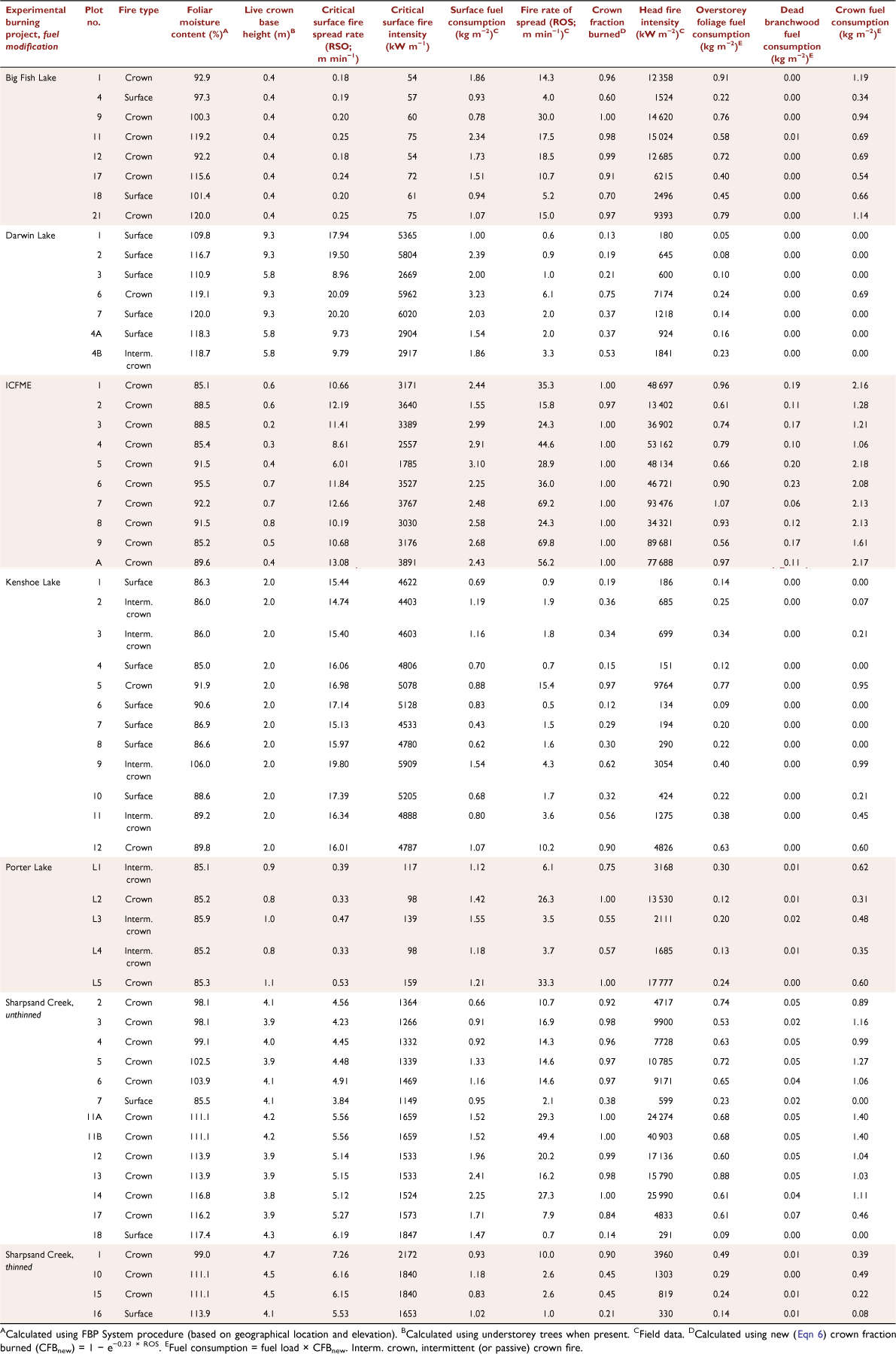Crown fuel consumption in Canadian boreal forest fires
William J. de Groot A , Chelene C. Hanes A * and Yonghe Wang BA Canadian Forest Service, Natural Resources Canada, Sault Ste Marie, ON, P6A 5M7, Canada.
B Canadian Forest Service, Natural Resources Canada, Edmonton, AB, T6H 3S5, Canada.
International Journal of Wildland Fire 31(3) 255-276 https://doi.org/10.1071/WF21049
Submitted: 14 July 2020 Accepted: 7 January 2022 Published: 28 February 2022
© 2022 The Author(s) (or their employer(s)). Published by CSIRO Publishing on behalf of IAWF. This is an open access article distributed under the Creative Commons Attribution-NonCommercial-NoDerivatives 4.0 International License (CC BY-NC-ND)
Abstract
Predictive crown fuel consumption models were developed using empirical data from experimental burning projects. Crown fuel load for foliage, bark, branchwood and stemwood were calculated for live overstorey and understorey trees in each plot using nationally derived tree biomass algorithms. Standing dead tree branchwood and stemwood biomass were similarly calculated. Crown bulk density values were calculated for all non-stemwood fuel components. Factors that affect the initiation and spread of crown fires (live crown base height, foliar moisture content, surface fuel consumption, critical surface fire spread rate, critical surface fire intensity) and components of the Canadian Forest Fire Weather Index System were not statistically significant variables. Crown bulk density was moderately correlated with crown fuel consumption but was not an influential factor. A new crown fuel consumption model was developed by regression analysis using fuel load of overstorey tree foliage and standing dead tree branchwood, and fire rate of spread through crown fraction burned. A simpler model was developed using only overstorey tree foliage fuel load and fire rate of spread. Both models provide forest and fire management agencies with enhanced ability to determine crown fuel consumption, fire behaviour and carbon emissions in boreal fires using basic forest inventory or biomass/carbon datasets.
Keywords: Canadian Forest Fire Behavior Prediction System, crown bulk density, crown fraction burned, crown fuel consumption, crown fuel load, dead branchwood biomass, fire rate of spread, foliage biomass, overstorey fuels, understorey fuels.
Introduction
In North America, the boreal fire regime is characterised by relatively infrequent large crown fires of high intensity (Van Wagner 1983; Stocks et al. 2003; de Groot et al. 2013). The post-fire burned area often appears as a patchwork mosaic of stands with fully consumed crowns, stands with scorched and/or partly consumed crowns, and stands with little or no crown fuel consumption. This spatial pattern in crown fuel consumption (CFC) reflects changes in fire behaviour due to local fuel characteristics, site moisture and topography as well as changing fire weather conditions (primarily wind speed and direction, and relative humidity) as a fire spreads across the landscape (Ryan 2002). Forest structure and fuels distribution are closely linked to fire behaviour (Agee 1996; Keane 2015) and the consumption of available crown fuels is an important factor affecting fire intensity (Rothermel 1991). Once a surface fire exceeds the critical surface fire intensity to become a crown fire, the final head fire intensity is determined by fuel consumption and rate of spread of the crown fire (Byram 1959; Van Wagner 1977; Alexander 1982). The transition from surface fire to crown fire is dependent on surface fuel consumption, surface fire rate of spread, foliar moisture content and the live crown base height (Van Wagner 1977).
There is wide variation in CFC across the boreal fire regime spectrum (de Groot et al. 2013). Crown fuels can be consumed in fires that range from low intensity and slow rate of spread (e.g. 700 kW m−1, 2 m min−1; Stocks 1989) with intermittent crowning (torching of single trees or groups of trees), to fast-spreading fully developed crown fires of extremely high intensity (e.g. 90 000 kW m−1, 70 m min−1; Stocks et al. 2004b). Accurate estimation of CFC is required for many fire and forest management applications. For example, fuel consumption is directly related to carbon emissions and CFC represents a large component of wildfire carbon emissions in Canadian forests (de Groot et al. 2007, 2013). CFC is also used to predict fire intensity, which is a critical factor affecting the ability of fire suppression resources to contain wildfire (Hirsch and Martell 1996), and numerous fire management guidelines are based on this relationship (Alexander and Cruz 2020). CFC and fire intensity also affect the post-fire regeneration of aerial seed-storing species such as jack pine (Pinus banksiana Lamb.) and black spruce (Picea mariana (Mill. BSP) (Viereck 1983; de Groot et al. 2004), and can prevent post-fire regeneration of annual seed-casting species such as white spruce (P. glauca (Moench) Voss) and balsam fir (Abies balsamea (L.) Mill.; Uchytil 1991; Abrahamson 2015). Therefore, CFC and fire intensity are important factors affecting post-fire successional trajectories.
The primary fuels burned in a boreal crown fire are conifer needles, bark flakes and small branches of live trees, and branches of standing dead trees (and bark, if present) (Van Wagner 1977; Cruz et al. 2003; Despain 2004; Reinhardt et al. 2006). Stocks et al. (2004b) found 95% of crown fuels consumed were needles and branches <1 cm diameter and limited consumption of branches 1–3 cm diameter. Cone material represents a minor component of the total crown fuel load consumed (Stocks et al. 2004b).
CFC is affected by numerous factors. The amount of crown fuel available for combustion, or fuel load, is a primary factor driving CFC (Rothermel 1991). Crown fuel load can also affect consumption by influencing crown fire spread (Cruz et al. 2003). An increased CFC rate (% of fuel load) occurs with decreasing moisture content and size class (diameter) of crown fuels (Call and Albini 1997).
Factors that affect the initiation and spread of crown fire can also potentially influence CFC. Obviously, surface fires that transition quickly to a full crown fire will burn more crown fuels than fires that are intermittently crowning or fires that remain on the forest floor. Crown fires that spread quickly are more likely to be active crown fires, while slower fire spread may result in a passive crown fire characterised by intermittent crowning (Van Wagner 1977; Cruz et al. 2005). Foliar moisture content and vertical continuity of fuels (e.g. live crown base height, or surface to crown fuel gap) are important characteristics affecting crown fire propagation (Van Wagner 1977; Cruz et al. 2003, 2004). Crown bulk density of aerial fuels is an important characteristic affecting crown fire initiation and spread (Van Wagner 1977; Cruz et al. 2003, 2005). Stand characteristics affecting crown bulk density are crown fuel load, live crown base height, tree height and tree density (Cruz et al. 2003; Keane et al. 2005; Reinhardt et al. 2006).
CFC of deciduous tree species is very small (or nil) and only occurs if the deciduous species form part of a conifer-dominated mixedwood stand. Owing to the high moisture content of deciduous leaves, broadleaf foliage may be scorched in a crown fire but there is limited consumption (Alexander 2010). Trembling aspen (Populus tremuloides Michx.) bark has very high moisture content and is seldom consumed by fire, but the fine papery bark of white birch (Betula papyrifera Marsh.) can be consumed, although it represents a very small portion of the consumed fuel load. For the purposes of fire behaviour modeling, fuel consumption in deciduous species is often ignored because of the small amount of fuel material available to be consumed and the limited amount of deciduous tree cover that is burned by crown fire.
In Canada, CFC is currently calculated using a model in the Canadian Forest Fire Behavior Prediction (FBP) System (Forestry Canada Fire Danger Group 1992; Wotton et al. 2009), which is a subsystem of the Canadian Forest Fire Danger Rating System (CFFDRS; Stocks et al. 1989). The FBP System is driven to a large degree by indices of the Canadian Forest Fire Weather Index (FWI) System (Van Wagner 1987), another subsystem of the CFFDRS. The FBP System is relied on extensively by Canadian fire agencies to make operational decisions based on predicted fire behaviour. The FBP System currently has 16 standard fuel types, each with standard fuel characteristics and fuel consumption algorithms. The Next-Generation CFFDRS (Canadian Forest Service Fire Danger Group 2021) is under development and will incorporate new modeling approaches to the algorithms to provide more dynamic and robust fire behaviour simulation, including fuel consumption. The purpose of the present study was to develop a new CFC model for Canadian boreal forests that can be incorporated within the Next-Generation CFFDRS design and applied operationally with standard available forestry, biomass and/or carbon datasets.
Methods
The new CFC model was developed by building on the current FBP System model and existing knowledge of boreal CFC. The new model was broadened to potentially include other factors that may affect CFC through crown fire initiation, fire spread and fuel characteristics. This study was based on field data from experimental fires used in the current CFC model of the 1992 FBP System, and additional experimental fire data obtained after the FBP System was published (details below). Abbreviations used in this study are listed after the Conclusions section.
Current CFC model
The FBP System has a CFC model that uses an algorithm to first calculate if a crown fire will occur. If a crown fire is predicted, it then calculates the amount of crown fuel consumed for the conifer component of the stand. The FBP System is currently based on 16 standard fuel types, of which 11 conifer and mixedwood fuel types are capable of supporting a crown fire, and each fuel type is characterised by a fixed crown fuel load value (Table 1). The 1992 FBP System calculates CFC as:

where CFL = crown fuel load (kg m−2) and CFB = crown fraction burned (proportional value).
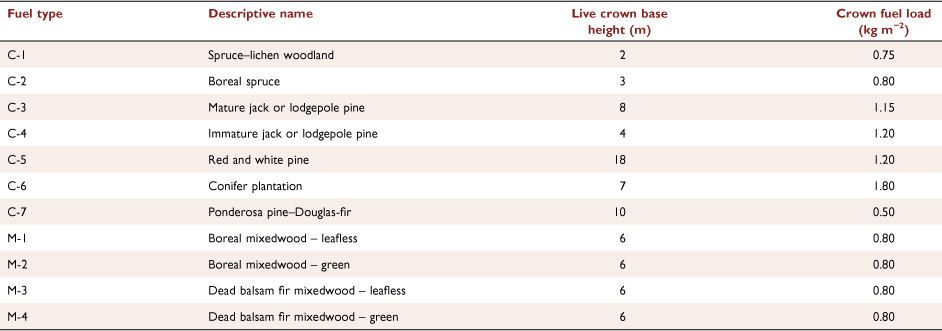
|
CFL is represented in the FBP System by a static value for each FBP fuel type, ranging 0.5–1.2 kg m−2 (Table 1). CFB is the proportion of tree crowns involved in the fire (CIFFC 2021) and is a scalar value (0–1) calculated using the final fire rate of spread (ROS, m min−1) for a surface or crown fire, and critical surface fire spread rate (RSO, m min−1):

By this equation, CFB is an inverse exponential function of the difference between ROS and RSO (Fig. 1). CFB = 0 when the surface fire ROS does not exceed the critical surface fire spread rate (i.e. the fire remains a surface fire) and CFB = 0.9 when fire ROS is 10 m min−1 greater than the RSO. The CFB model (Van Wagner 1993) was originally developed as a transition function to calculate fire ROS as it progresses from a surface fire-controlled ROS (CFB = 0) to a crown fire-controlled ROS. The FBP System uses CFB to calculate final fire ROS for the C-6 fuel type (Conifer plantation), which has a dual-equation (surface fire and crown fire) ROS model. CFB is also used to calculate CFC with Eqn 1 for all FBP System fuel types.
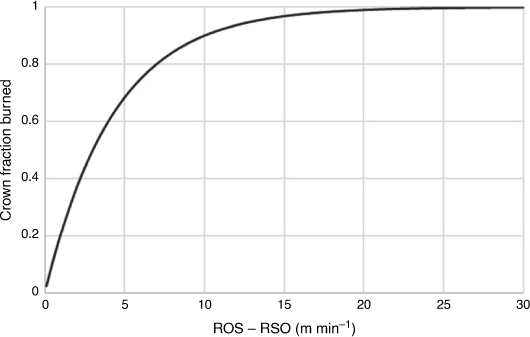
|
Using Byram’s (1959) fire intensity equation:

where I = fire intensity (kW m−1), h = fuel low heat of combustion (kJ kg−1), w = fuel consumed per unit area in the active flame front (kg m−2), and r = rate of forward spread (m s−1).
Using a fuel low heat of combustion (h) value of 18 000 kJ kg−1 (Van Wagner 1972), the critical surface fire spread rate (RSO) is calculated by:

where CSI = critical surface fire intensity (kW m−1) and SFC = surface fuel consumption (kg m−2).
The CSI is calculated using Van Wagner’s (1977) critical surface fire intensity model:

where LCBH = live crown base height (m) and FMC = foliar moisture content (%).
The FBP System assumes a reference live crown base height for each FBP fuel type, ranging 2–18 m (Table 1). Conifer foliar moisture content is calculated using an algorithm based on location (latitude, longitude), elevation and Julian date of the fire with reference to a historical dataset of documented spring budflush dates. Foliar moisture content is known to decrease from a normal high value of 120% during most of the growing season, to as low as 85% during a ‘spring dip’ period near the time of new foliage budflush (Forestry Canada Fire Danger Group 1992). During this period of low foliar moisture content in the spring, the potential for crown fire development is at its highest.
New model development
The CFC models developed in this study were based on empirical data from experimental fires. The data represent fires in coniferous stands including those characterised by surface fire, intermittent (passive) crowning and fully developed (active) crown fires. Therefore, the model reflects the full range of potential CFC that can occur in Canadian boreal forest fires. Only line-source, experimental fires with plot-level data were included in this study. Data from 59 fires were compiled from six experimental burning projects (Table 2). Data from five of the experimental burning projects form part of the FBP System database (Forestry Canada Fire Danger Group, unpubl. Canadian Forest Service (CFS) report 1993). The International Crown Fire Modeling Experiment (ICFME) was conducted during 1997–2000 and represented new experimental data for CFC model development. A summary of site conditions and data collection procedures for each experimental burning project is presented in the following section. Additional specific details can be found in the cited references.
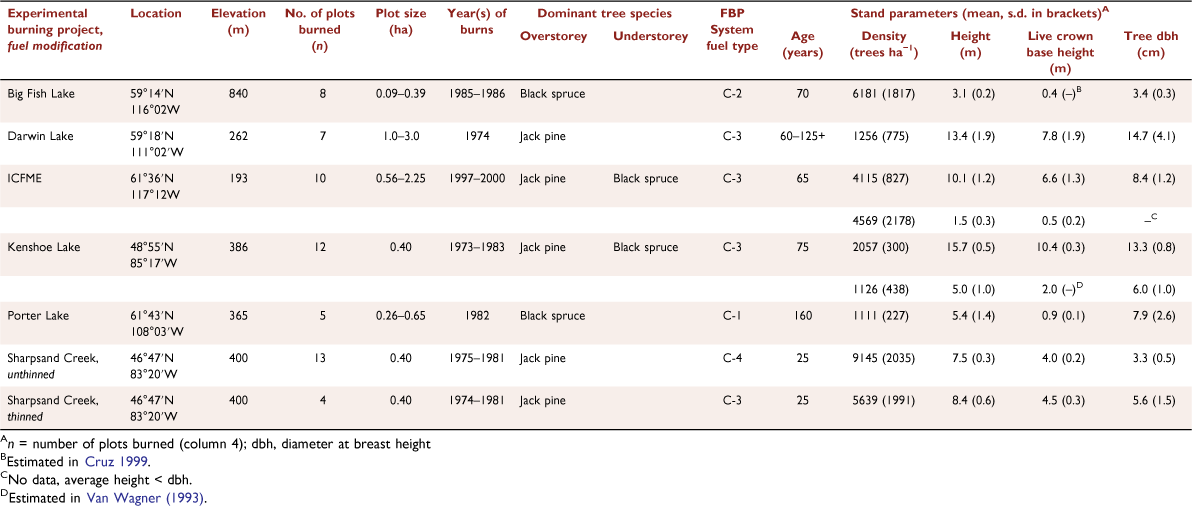
|
Field site descriptions
All projects were located on level terrain. Four of the experimental burning projects were conducted in jack pine-dominated stands, and two were in black spruce stands. The Darwin Lake project (Quintilio et al. 1977) was located in upland jack pine stands on the Canadian Shield of northeastern Alberta (Fig. 2). Six plots, each 1–3 ha in area, were located on very dry sites and burned in 1974. The plots were characterised by a low-density stand of tall, mature jack pine with high live crown base height (Table 2). One plot was split into two subplots (4A and 4B) burned on different days, resulting in a total of seven observations in the Darwin Lake dataset.
The Sharpsand Creek experimental burning project in northeastern Ontario was conducted using 0.4-ha plots in a very dense and pure stand of young jack pine (Walker and Stocks 1975; Stocks 1987). Trees had very small diameter, and moderate height and live crown base height in comparison with the Darwin Lake project. The stand had experienced significant self-thinning, and dead trees represented over half of all standing stems. A total of 16 plots were burned at Sharpsand Creek. Twelve plots were burned during 1975–1981, of which one plot provided two sets of data because wind speeds increased dramatically when the plot was half burned, creating substantially more intense fire behaviour conditions. Therefore, this plot was subdivided into two subplots (11A, 11B). The remaining four plots at Sharpsand Creek were manually thinned in 1960 to remove the smallest stems, which were left on site. This slash material was well incorporated in the forest floor layer when plots were later burned from 1974 to 1991. These plots were characterised by much lower density stands than the original unthinned plots, and trees of slightly higher stem diameter, height and live crown base height.
The Kenshoe Lake project in north-central Ontario used 0.4-ha plots established in a mature jack pine stand of moderate density, height and live crown base height, with a well-established black spruce understorey component (Walker and Stocks 1975; Stocks 1989). This project provided data from 12 experimental fires.
The ICFME project was conducted in a high-density, semi-mature jack pine stand in the southwest region of the Northwest Territories (Stocks et al. 2004a). There was a black spruce understorey component that varied in density between plots (Alexander et al. 2004; Stocks et al. 2004b). Data were collected for 10 experimental plots of 0.56–2.25 ha that were burned during 1997–2000.
A black spruce–lichen woodland stand was burned in the Porter Lake experimental burning project in the southeast region of the Northwest Territories (Alexander et al. 1991). The stand was characterised by sparsely stocked and open black spruce with scattered jack pine trees and clumps of white birch. Five plots were burned by line ignition in 1982 and were included in the current study. Plot sizes were 0.26–0.65 ha in area.
Lastly, the Big Fish Lake experimental burning project was conducted in a lowland black spruce stand in the Cariboo Mountains of north-central Alberta. The study area was characterised by a semi-mature pure black spruce stand of low tree height and moderate stand density, and was located on permafrost peatland. Eight experimental fires were conducted during 1985 and 1986 in 0.09–0.39-ha plots that were used in this study.
Fuels data collection
Forest stand data (Table 2) were collected by various methods. Tree species composition, dbh (1.3 m) and stem density were collected at the Darwin Lake project using a 10-factor wedge prism, ICFME using a point-centred quarter method, and all other experimental burning projects using a strip cruise that varied from 10% sampling (by area) at Sharpsand and Kenshoe to at least 40% at Porter Lake. By these methods, dbh frequency distribution data were available for all plots except at the Darwin Lake project, which only provided average dbh and stem density values for each plot. Tree height was measured by hypsometer and direct measurement of felled trees. Average tree height and stem density data for overstorey and understorey trees were available for each plot. Live crown base height was determined using understorey trees if present; otherwise, it was determined using overstorey trees. Live crown base height was directly measured only at the Porter Lake and ICFME sites. At the Darwin Lake project, live crown base height for individual plots was calculated by subtracting the average crown length (5.6 ± 1.0 m, n = 8) for the experimental site from the plot-level tree height values. The live crown base height for plots at the Sharpsand Creek were calculated using dbh–live crown base height regressions derived from local tree sampling.1 Understorey live crown base height was estimated as 2 m for all plots at the Kenshoe Lake project (Van Wagner 1993), and 0.4 m for all plots at the Big Fish Lake project (Cruz 1999), which was a relatively open grown stand of short black spruce.
Fire weather data collection
On-site fire weather stations were established soon after spring snowmelt, and were operated following the standards and practices described by Turner and Lawson (1978) and Lawson and Armitage (2008). FWI System parameters were calibrated to the project site using basic spring startup values for Fine Fuel Mositure Code (FFMC) and Duff Moisture Code (DMC) (Canadian Forest Service 1984) and overwinter-adjusted Drought Code (DC), if needed (Lawson and Armitage 2008). The FWI System parameters were calculated daily using noon standard weather readings (Van Wagner 1987). This was supplemented with hourly weather readings of FWI weather parameters (temperature, rainfall, relative humidity and 10-min average wind speed and direction) to provide broader general information and awareness of local weather and synoptic conditions. At ICFME, upper atmosphere conditions were also monitored by balloon-launched radio sonde, as equipment was available. During the experimental fires, relative humidity was constantly monitored on site, and wind speed and direction data were collected immediately adjacent to the burn plots on a continuously monitored basis. These data were used to carefully adjust the ISI and FWI parameters to the detailed burning conditions that occurred exactly when the experimental fire was conducted.
Experimental burning procedures
Timing of experimental fires was planned to achieve a wide range in fire weather conditions. Small plots were used for slow-spreading fires and large plots were used for fast-spreading fires to ensure that steady-state fire behaviour could be documented within the plot boundaries. Fires were ignited by various methods, depending on project location and equipment availability. Most fires were started by two people carrying drip torches to ignite surface fuels along the windward plot edge, starting at the plot centre. In at least one case (Porter Lake), a plot was lit using fusees, while some plots were ignited using a pressurised flamethrower (Porter Lake) or similar method using a truck-mounted Terra Torch (ICFME). All ignition tools and methods worked equally well in establishing a continuous line-source fire along the upwind side of the plot (Alexander and Quintilio 1990).
Fire behaviour data collection
Fire behaviour was measured for each plot using data collected before, during and after the burn. Each plot provided a single observation of each fire behaviour parameter for statistical analysis. Fire ROS documentation began immediately at ignition, and was measured by various methods. On many slow-spreading fires, numbered metal tags were dropped at the fire edge at timed intervals and spread distances were measured post fire. On fast-spreading fires, electronic timers and dataloggers with thermocouples were buried in a gridded pattern in the plot. These data were supplemented with time-stamped video and photos from ground and aerial viewpoints that could be matched with a visible grid of flagged metal pins within the plot to determine the time when the fire reached a specific gridpoint location. Post-fire analysis of spread rate data was used to determine the time when the fire reached equilibrium spread rate, which occurred soon after the line source fire was ignited on all fires. The fire behaviour data recorded for each plot represent measurements collected after the point of equilibrium spread rate was reached. Therefore, the fire behaviour data are representative of a free-burning fire in steady state condition, and in equilibrium with the measured environmental conditions.
Fuel consumption was determined using pre- and post-burn sampling of the forest floor (or ground), surface and crown fuel layers. All organic forest floor fuels were sampled destructively within the burn project area and outside the experimental plots to prevent disturbance of natural fuel conditions in the plots. Intact organic soil monoliths (30 × 30 cm) were carefully exposed by removing surrounding ground material down to mineral soil, or below the expected depth of burn if it was a deep organic site. Litter, fermentation and humus components were removed separately in horizontal layers of 2-cm depth or less. All layers were oven-dried to constant weight. In samples where there was mixing at the organic and mineral soil interface, samples were ashed in a muffle furnace to determine mineral soil content, which was subtracted from the sample layer weight. Data from all monoliths were used to calculate average organic soil bulk density by individual layer depths. Depth-of-burn pins, which have a horizontal bar (~5 cm long), were placed in a grid pattern within the plot immediately prior to burning, with careful placement of the horizontal bar at the organic soil surface. After the fire, depth of burn was measured from the horizontal bar to the top of unburned organic soil, or mineral soil surface if complete combustion occurred. Depth of burn measurements were averaged by plot and applied to the average organic soil bulk density profile for the project area to calculate average forest floor fuel consumption per plot.
Herbaceous and shrub vegetation, if present, was sampled prior to burning using 1-m2 clip plots. Samples were oven-dried to constant weight to determine preburn fuel load. Post-burn sampling was only conducted if any material remained after burning, although this seldom occurred for the herbaceous layer. If herbaceous plants or shrubs were scarce and it was determined that these fuels would have negligible contribution to overall fuel consumption, they were not sampled (e.g. Stocks et al. 2004b). These fuels were only sampled at the Sharpsand, Kenshoe and Big Fish Lake projects.
Dead and downed woody debris fuel load was measured using a line intercept method (Van Wagner 1968). General procedures, using a triangular transect layout, are described by McRae et al. (1979). Permanent transects were established within each plot. Dead woody debris fuel consumption was calculated by comparing pre- and post-burn fuel loads along each transect. Dead woody debris fuel consumption data were summarised at the plot level for multiple roundwood size classes by averaging the transect results.
Preburn crown fuel load was estimated at each experimental burning project using dbh-based regression models. Crown fuel load (needles and dead branchwood <1 cm diameter) was calculated using locally derived dbh-based equations from destructive sampling of 24 live trees and 11 dead trees at Sharpsand, and 30 overstorey and 35 understorey trees at Kenshoe (Walker and Stocks 1975). Jack pine crown fuel equations were developed for Darwin Lake using 10 sample trees (Alexander et al. 1991) with size classes of 0–0.64 cm (including foliage) and 0.65–1.27 cm. The Porter Lake project considered crown fuels to be foliage and roundwood material ‘less than about 0.5 cm in diameter’, although data are presented as <0.64 cm (Alexander et al. 1991). Crown fuel load at Porter Lake was calculated using aerial biomass equations from northern Quebec (Rencz and Auclair 1980) for black spruce, and equations for jack pine from the Darwin Lake project. The ICFME project conducted detailed sampling of crown fuel load by destructive sampling of 106 overstorey and understorey trees for foliage and roundwood diameter size classes by 1-m height increments.
At all experimental burning projects except ICFME, CFC was estimated by Eqn 1 using preburn crown fuel load and a post-fire ocular estimate of crown foliage loss, representing crown fraction burned. At ICFME, post-burn crown fuel loads were measured by destructive sampling of burned trees, and CFC was calculated by comparing estimated preburn fuel load (by dbh-based regression model) and post-burn measured fuel load.
Head fire intensity was calculated with Byram’s (1959) formula (Eqn 3) using fire ROS and total fuel consumption (ground, surface and crown layers) for each plot. Fire behaviour data for each plot (Table 2) represent a single data point for each parameter.
Data preparation
Fire weather conditions for each experimental fire were described using components of the FWI System (Table 3) that were obtained from experimental burning project publications and CFS file reports.2 (The FWI System has six components that represent fuel dryness and potential fire behaviour at the landscape level: FFMC is an indicator of the dryness of dead fine fuels, often used as a predictor of human- and lightning-caused fires; DMC indicates dryness of loosely compacted, upper organic layers of the forest floor, often used as a predictor of lightning-caused fires; DC indicates dryness of deep compact organic layers in the forest floor; Initial Spread Index (ISI) is an indicator of rate of fire spread; Buildup Index (BUI) indicates dryness of medium and large dead fuels; FWI is a general indicator of fire danger and fire intensity.) Fire behaviour data for surface fuel consumption, CFC, fire ROS and head fire intensity were similarly compiled for each experimental burn. Foliar moisture content was calculated following FBP System procedures using location, elevation and Julian date of burn data, as similarly done by Call and Albini (1997). Live crown base height was used with foliar moisture content to calculate critical surface fire intensity (Eqn 4), RSO (Eqn 3) and crown fraction burned (Eqn 2).

|
Crown fuel load and bulk density were calculated for each plot. Current literature shows that these characteristics have been measured using different crown fuel components. For example, Cruz et al. (2003) calculate crown bulk density using foliage fuel load only, which is consistent with Van Wagner’s (1977) crown fire initiation and spread model (Alexander and Cruz 2014). Others have used foliage plus 50% of branches <0.25 in (~6 mm) diameter (Reinhardt and Crookston 2003), foliage plus branches <3 mm diameter (Alexander 1988; Finney 1998), foliage plus live branches <3 mm diameter plus dead branches <6 mm diameter (Keane et al. 2005), and foliage plus all branches (Keane et al. 2005).
For the present study, crown fuel load was calculated using tree measurement field data for multiple components of three fuel layers: live overstorey trees, live understorey trees and dead standing trees. When distinct overstorey and understorey cohorts were present in the stand, understorey trees were defined using Alexander et al. (2004) criteria as having a dbh < 3 cm, and overstorey trees were dbh ≥ 3 cm. Stand composition of some plots included minor amounts of aspen and white birch, but the biomass of these tree species was not included in fuel load calculations because their contribution to CFC was very little to none (e.g. Quintilio et al. 1977; Alexander et al. 1991).
Average aboveground tree biomass (kg tree−1) for each of the three stand components in each plot was calculated using tree dbh data with allometric equations of Lambert et al. (2005), which partitions individual tree biomass as foliage, branchwood, bark and stemwood. Crown fuel load (kg m−2) was calculated for each stand component using individual tree biomass and stand density (trees ha−1) data. Crown fuel load was calculated separately for live tree overstorey and understorey components in each plot using the following five fuel categories: (i) total crown fuel load (stemwood, branchwood, bark, foliage); (ii) branchwood, bark and foliage; (iii) branchwood and foliage; (iv) bark and foliage; and (v) foliage only. The crown fuel load of dead trees was calculated using the same procedure for two fuel categories: (i) stemwood plus branchwood; and (ii) branchwood only. Bark and foliage were assumed to not be present on dead standing trees.
Crown bulk density (kg m−3) was determined for each of the three stand components (live overstorey, live understorey and dead standing trees) using different combinations of fine and medium fuels in each component. Crown bulk density was calculated as crown fuel load divided by crown length, which was equal to tree height minus live crown base height. Crown bulk density was determined separately for live overstorey and understorey trees in each plot using four fuel categories: (i) branchwood, bark and foliage; (ii) branchwood and foliage; (iii) bark and foliage; and (iv) foliage only. Crown bulk density for dead trees was calculated for branchwood only, since bark and foliage were assumed not to be present on dead trees.
Data analysis
A predictive CFC model was developed by regression analysis using fire weather variables, fire behaviour variables and physical tree variables known to influence crown fire initiation, spread and fuel consumption. Fire weather variables were represented by the six FWI System components (FFMC, DMC, DC, ISI, BUI, FWI). Tree variables were: (i) foliar moisture content; (ii) live crown base height; (iii) overstorey and understorey live tree crown fuel load (by individual and combined components of stem, branch, bark and foliage) and crown bulk density (by individual and combined components of branch, bark and foliage), and standing dead tree fuel load (branch plus stem and branch only) and crown bulk density (branch only). Fire behaviour variables were (i) fire ROS; (ii) surface fuel consumption; (iii) critical surface fire spread rate; (iv) crown fraction burned; and (v) critical surface fire intensity.
We first conducted Pearson correlation analyses between CFC and all variables for intercomparison, and to select fuel load and bulk density variables for use in the regression analyses. Only one crown fuel load and one bulk density variable from each of the overstorey tree component, the understorey tree component and the dead tree component (maximum of six parameters in total) were used for further analysis by selecting the variable with highest correlation to CFC. This was done to prevent using the same fuel variable more than once in the same model (e.g. using foliage and foliage + bark). Fuel consumption was calculated for the overstorey, understorey and dead tree fuel layers using the fuel load value for the component selected and crown fraction burned (Eqn 1). Correlation analysis between CFC and fuel consumption calculated for these three fuel layers was also conducted.
The CFC models were developed using a backwards stepwise regression procedure. At each regression step, any independent variable that was not significant (α ≤ 0.05) was removed from the model, and another analysis was conducted using the remaining variables. This was repeated until only significant independent variables remained in the model. Owingto scarcity of CFC data and lack of an independent test dataset, the CFC models were developed using all available data (n = 59) and were tested using three cross-validation methods to assess predictive capability of the fitted regression models: K-Fold Cross Validation (KFOLD) (Stone 1974), Leave-One-Out-Cross-Validation (LOOCV; a special case of the K-Fold Cross Validation), and Bootstrapping (Efron and Tibshirani 1993). Specifically, in the KFOLD procedure, the data were randomly split into 10 groups. Our model was fitted on data from nine groups, and the model with estimated parameters was then applied to the one remaining group of test data to generate Mean Squared Error (MSE) and Mean Absolute Error (MAE) statistics. This procedure was repeated 10 times, once for each group serving as test data. The LOOCV procedure was very similar to KFOLD, except our model was fitted on all data except one observation, which was used for testing with the model and estimated parameters for MSE and MAE. This was repeated 59 times, once for each observation serving as test data. In the Bootstrapping procedure, we repeatedly sampled the data randomly with replacement 1000 times to create 1000 simulated samples of size 59. We fitted our regression models on each of the 1000 random samples and used the fitted models to predict CFC, which generated 1000 MSEs and MAEs. MSE and MAE statistics were used to evaluate the models and make inferences on the original dataset.
Results
There were a total of 59 experimental burn plot observations used in the analyses. Understorey trees formed part of the live stand composition on 22 of the plots (all plots at Kenshoe Lake and ICFME), and standing dead trees were present on 39 of the plots (all 17 Sharpsand Creek plots, all 10 ICFME plots, 4 Darwin Lake Plots, 3 Big Fish Lake plots and all 5 Porter Lake plots). The dataset included surface, intermittent crowning and full crowning fires (Table 4) with head fire intensities of 134–93 476 kW m−1, and fire ROS of 0.5–69.8 m min−1. Total crown fuel load of live overstorey trees was 0.74–16.27 kg m−2, of which foliage represented 0.12–1.07 kg m−2 with crown bulk density of 0.04–0.36 kg m−3 (Table 5). Understorey live crown fuel load was 0–2.56 kg m−2, including foliage fuel load of 0–0.37 kg m−2 with crown bulk density of 0–0.14 kg m−3. Total aboveground dead crown fuel load was 0–1.95 kg m−2, of which branchwood was 0–0.23 kg m−2. CFC was 0–2.18 kg m−2 and crown fraction burned was 0.00–1.00.
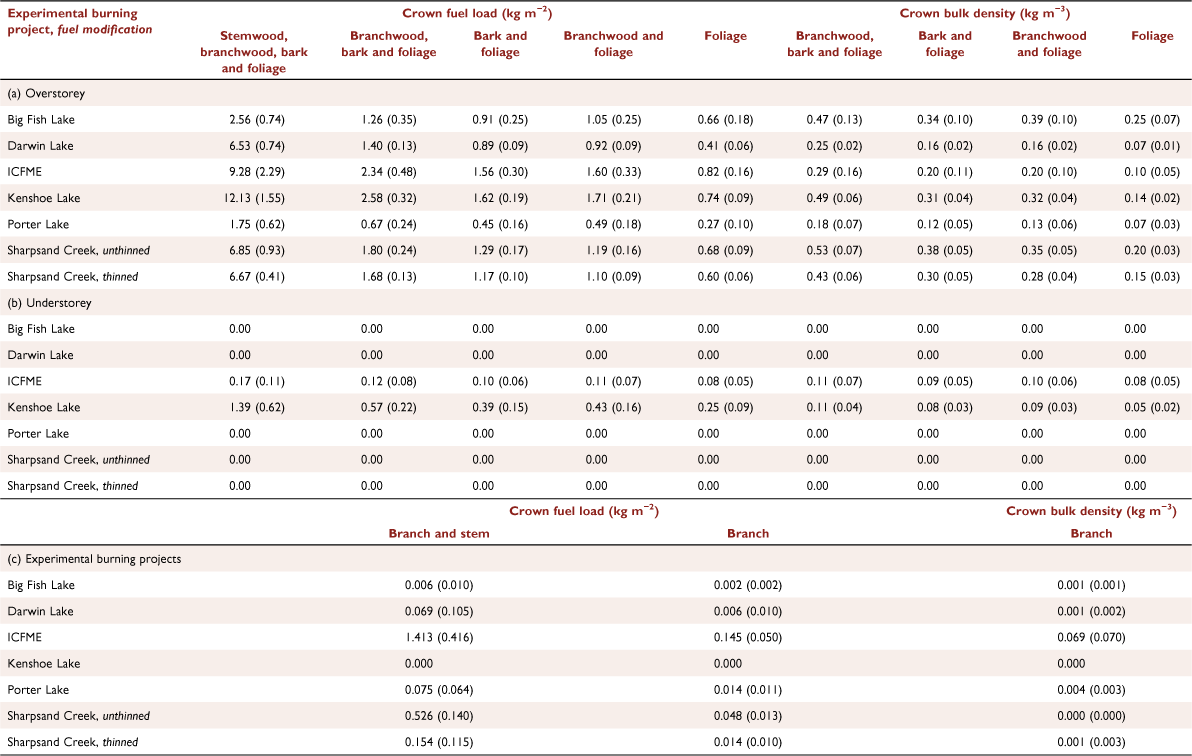
|
Fire ROS (r = 0.79), dead branchwood fuel load (r = 0.74) and dead branchwood + stemwood fuel load (r = 0.73) showed strong correlations with CFC (Tables 6, 7). Overstorey foliage fuel load (r = 0.50) and crown fraction burned (Eqn 2) (r = 0.49) showed moderate correlation. The crown bulk density of overstorey foliage, overstorey foliage + bark, understorey foliage, and understorey dead branchwood also showed low to moderate correlation (r = 0.40–0.52). The FWI System components had generally low correlation although DC and BUI showed r = 0.63 and r = 0.42, respectively.
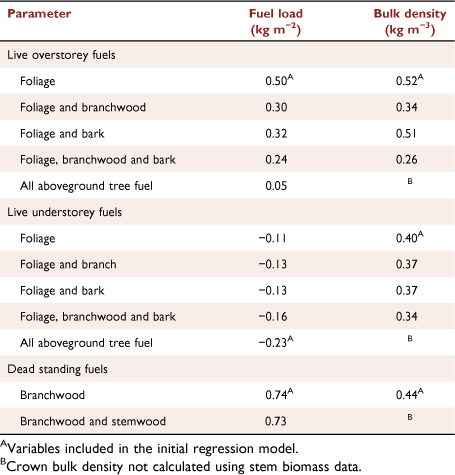
|
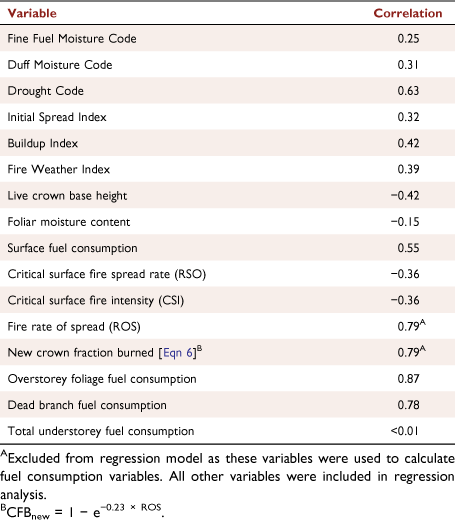
|
Critical surface fire spread rate (RSO) showed low correlation with CFC (r = −0.36) and further testing by regression showed it was not a significant independent variable. However, RSO was used to calculate crown fraction burned (Eqn 2). Therefore, crown fraction burned was recalculated using only fire ROS:

This revised equation removed critical surface fire spread rate from the data calculations while still maintaining key calibration points of CFB = 0 when ROS = 0, and CFB = 0.9 when ROS = 10 m min−1. The recalculated crown fraction burned variable (CFBnew) was strongly correlated with CFC (r = 0.79, Table 7). Using CFBnew, fuel consumption (Eqn 1) of overstorey foliage and dead branchwood showed strong correlation with total CFC (r = 0.87 and r = 0.78, respectively; Table 7). However, fuel consumption of (total) understorey fuels showed very weak correlation (r < 0.01) with CFC.
Crown fraction burned and fire ROS were excluded from the regression analysis as these variables were used to calculate fuel consumption variables. Similarly, fuel load variables for the three fuel layers (overstorey, understorey, dead branchwood) were excluded because those variables were also used to calculate fuel consumption. The regression analysis was then initiated with 16 independent variables in the model (Tables 6, 7): overstorey foliage fuel consumption, dead branchwood fuel consumption, understorey total fuel consumption, overstorey foliage bulk density, dead branchwood bulk density, understorey foliage bulk density, live crown base height, foliar moisture content, surface fuel consumption, critical surface fire intensity, and the six fire weather variables (FFMC, DMC, DC, ISI, BUI, FWI).
There were four statistically significant variables after the first step: overstorey foliage fuel consumption, dead branchwood fuel consumption, understorey total fuel consumption and understorey foliage bulk density. ISI (P = 0.09) and overstorey foliage bulk density (P = 0.07) were marginally significant but did not meet selection criteria and were excluded from further analysis. All other variables were not significant. In the second backwards regression step, understorey total fuel consumption was marginally significant (P = 0.08) and was removed from the model. In the third regression step, understorey foliage bulk density was not statistically significant (P = 0.37) and was removed. The final regression model was derived by expressing the two remaining significant model variables (overstorey foliage and dead branchwood fuel consumption) in terms of the original variables driving those parameters (ROS, and overstorey foliage and dead branchwood fuel loads) (P ≤ 0.001, adj. R2 = 0.86, SEE (standard error of the estimate) = 0.25):

where FLOfol = fuel load of overstorey foliage (kg m−2), FLDBr = fuel load of dead branchwood (kg m−2).
For datasets that may not include standing dead tree (snag) data, another model requiring only live overstorey tree data was also developed (P = 0.001, adj. R2 = 0.76, SEE = 0.32):

Figs. 3, 4 illustrate the expected predictability of the models over the range of data used for Eqn 7 and 8, respectively. Eqn 7 had MSE = 0.06 and MAE = 0.19, which were lower than found for Eqn 8, with MSE = 0.10 and MAE = 0.25. By comparison, the MSE and MAE values of KFOLD and LOOCV are larger, and the same statistics of Bootstrapping are smaller (Table 8). Fig. 5 presents the frequency distribution of predictive errors for Eqn 7 and 8.
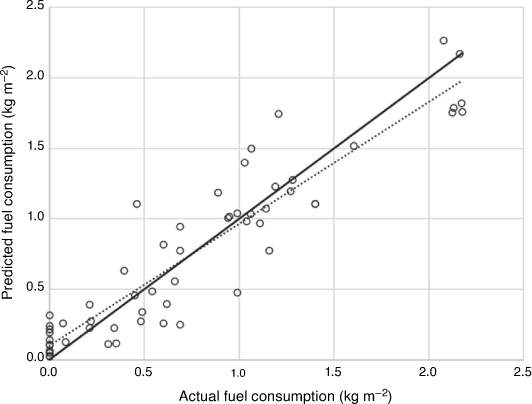
|
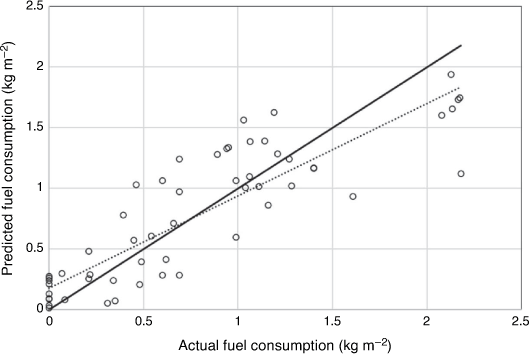
|
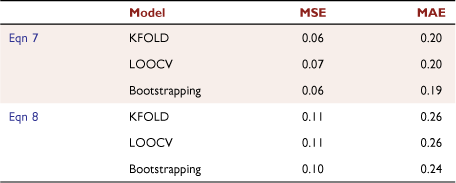
|
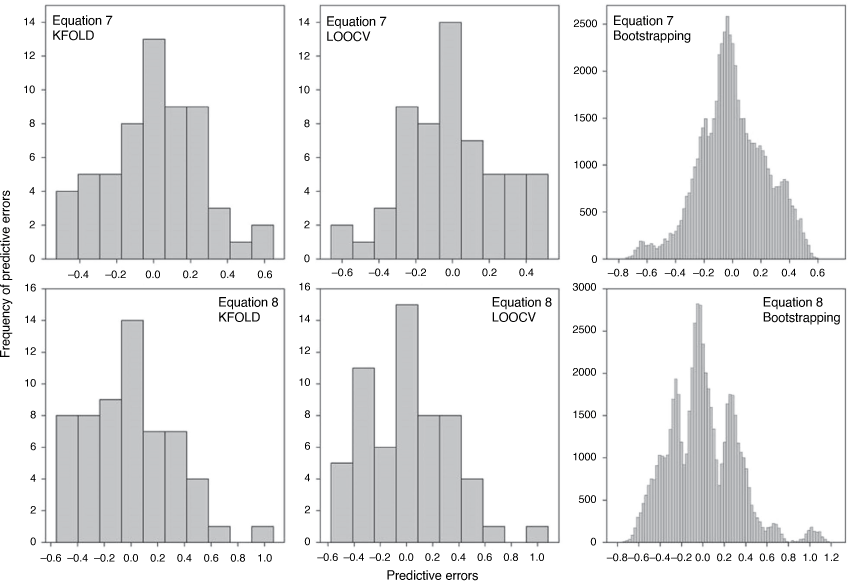
|
Discussion
Model statistics show that Eqn 7 and 8 are reliable predictors of CFC. Cross-validation and Bootstrapping show that the models are fairly accurate, and robustness of the models is further supported by the frequency distribution of predictive errors that are distributed around zero. Eqn 7 provides more accurate predictions than Eqn 8 since it has three prediction variables, rather than two in Eqn 8. Including the dead branchwood term substantially increased explanatory power.
Variable crown fuel load input, which allows fuel load to be adjusted by tree species composition, height, dbh, stand density and any other factors that are used in local tree growth and biomass algorithms, is a primary reason for the reliable prediction capability of these models. For that reason, these new models are more robust than the current model in the1992 FBP System, which is limited by static crown fuel loads (and therefore, maximum CFC values) of 0.75–1.20 kg m−2 for the fuel types in this study (maximum CFC in this study was 2.18 kg m−2).
Overstorey foliage fuel loads were much higher than dead branchwood fuel loads (Table 5). Every plot in the database had overstorey foliage fuels, but dead branchwood fuels were only present on 30 of the 59 plots, which explains the stronger influence of overstorey foliage on CFC (Table 6, 7). Understorey fuels were only present on 21 of the 59 plots and values were much lower than overstorey fuel loads, and for that reason, understorey fuels did not have a statistically significant influence on CFC. Fire ROS was an important factor to CFC because it drives crown fraction burned (Eqn 6).
Surface fuel consumption, live crown base height, critical surface fire intensity and critical surface fire spread rate are all factors that affect crown fire initiation but none of these variables were significant in the CFC models. The practical implication of these findings is that CFC can be calculated using a crown fraction burned value that is based solely on fire ROS (Eqn 6), which is a primary prediction output of the FBP System. The critical surface fire spread rate (RSO in Eqn 2) is dependent on surface fuel consumption and critical surface fire intensity (Eqn 3), which are both difficult to predict with accuracy. Removal of critical surface fire spread rate from the CFC calculations prevents introduction of error related to calculating surface fuel consumption and critical surface fire intensity. The latter is dependent on live crown base height and foliar moisture content (Eqn 4) and both of these variables were found to be not statistically significant factors in CFC. Alexander and Cruz (2013) found no significant influence of foliar moisture content on crown fire spread in empirical datasets, which may at least partially explain the lack of effect on CFC.
Although crown bulk density variables for the three fuel layers (overstorey, understorey and dead trees) showed moderate correlation to CFC (Table 6), crown bulk density was not a statistically significant variable. Crown bulk density is widely recognised as a factor affecting crown fire initiation and active crown fire spread, with generally accepted threshold values of 0.05 and 0.10 kg m−3, respectively (Alexander and Cruz 2014). In the present study dataset, crown bulk density values for overstorey foliage were ≥0.10 kg m−3 on 48 of the 59 plots. All seven plots on the Darwin Lake project (0.06–0.09 kg m−3) and four of the Porter Lake plots (0.04–0.09 kg m−3) had lower crown bulk densities values. It should also be noted that the Porter Lake project was located in the spruce–lichen woodland (C-1) FBP System fuel type, which is characterised by dense clumps of fairly short black spruce trees of variable heights. Therefore, this fuel type has a low average crown bulk density but it is better characterised as an open fuel type with many pockets of low branching trees with high-density fine fuels >0.10 kg m−3, which readily support crown fire. Overall, there was only 1 out of 59 plots that had a crown bulk density <0.05 kg m−3, so this variable was not a limiting factor to crown fire initiation. For that reason, crown bulk density was not an influential factor in this study.
None of the FWI System components showed a statistically significant influence on CFC in this study. DC, which is an indicator of long-term drying, had the highest correlation with CFC (0.63) of all FWI System components. DC had a range of 60–410, which represents low to moderate values in Canada. It is possible that DC becomes an influential factor on CFC under extended drying conditions, particularly since DC represents moisture content of heavy forest fuels (e.g. large-diameter deadwood), and dead branchwood fuel load was found to be an important factor in this study. ISI is a good indicator of fire ROS when fuel type and topography are accounted for (Forestry Canada Fire Danger Group 1992), and it was marginally significant in the first step of the analysis. However, fuel type variability in this study limited the potential influence of ISI as a driving predictive variable of CFC.
Although ISI and the understorey fuel variables (i.e. bulk density of understorey foliage and fuel load of total understorey fuels) were not statistically significant at α = 0.05, their low P values in early regression steps suggest possible influence and should not be discounted outright (Wasserstein et al. 2019). When these three variables were included in a regression analysis with the variables of Eqn 7, the resulting model explained an additional 3% of variability beyond Eqn 7 for this dataset. In all likelihood, understorey fuels will have a slightly stronger influence on CFC in cases where there is a greater amount of understorey fuels present. Including only the ISI variable in analysis with the other variables of Eqn 7 explained an additional 1.5% of variability. It is not expected that ISI will have a stronger influence than this in other datasets as fire ROS is already a variable in the current models.
There were limitations in the datasets used in this study. The experimental burning projects were planned and conducted over a period of three decades and different sampling methods were used for data collection during that time. However, all of these field studies were conducted by the same core group of researchers, so there is known consistency in data measurement and preparation of experimental datasets. Despite that, data for some variables used in this study were not available for all field experiments, and some variables had to be estimated. For example, plot-level dbh distributions were available for all experimental burning projects except Darwin Lake, for which only average dbh was available. Live crown base height data were not available for most plots and were estimated using other stand data. Foliar moisture content data were also incomplete for the dataset, so all foliar moisture content values were estimated using the FBP System procedure to be consistent across the entire dataset. It is difficult to determine the effect of error associated with these database limitations on the final models. However, data compilation procedures were consistent and rigorously followed to ensure the dataset was as accurate as possible.
The method used to determine preburn crown fuel load and CFC varied between experimental burning projects. Slightly different diameter size classes were used to determine preburn crown fuel load. However, the error associated with this is expected to be small since post-burn crown fuel sampling at ICFME showed 95% of CFC was <1.0 cm diameter and crown fuel load measurements and calculations were based on foliage and small-diameter crown material at all experimental burning projects. ICFME was the only project to estimate CFC using direct sampling of post-burn crown fuels, while all other projects used an ocular estimate of crown fraction burned to calculate CFC. The ICFME project had the highest CFC values overall, but it also had the highest fire ROS, and overstorey and dead branchwood fuel loads. Consistency in the pattern of CFC results even though different calculation methods were used provides confidence in the dataset.
Preburn crown fuel load was calculated in this study using national tree biomass algorithms (Lambert et al. 2005). This applied a consistent estimation procedure across the dataset and demonstrated that a high level of CFC model prediction accuracy can be realised using national biomass algorithms. Regional or local biomass algorithms may provide even greater accuracy, but these are often not available.
This study demonstrated that ROS, and overstorey foliage and dead branchwood fuel loads are key drivers of CFC. However, there are other fine-scale factors such as fuel structure that affect convective and radiative heat transfer and subsequent CFC (Pimont et al. 2009; Hoffman et al. 2012). Ritter et al. (2020) noted that fine-scale patterns in crown spacing and tree group size affect heat transfer from a surface fire to tree crowns, influencing crown ignition and consumption. Individual and small groups of trees are exposed to less thermal energy so a higher level of surface fire intensity is required to initiate torching, resulting in less CFC. Increased crown separation distance also reduced heat transfer and CFC. These fine-scale fuel characteristics may have affected the Porter Lake burns where tree fuels were separated and clumped, but it would have little, if any, influence on the other experimental burns, which were characterised by continuous crown fuel layers that are typical of North American boreal forests (Van Wagner 1983). Ritter et al. (2020) also note that fine-scale fuel characteristics are influential near the point of crown fire threshold, and have no influence when surface fire intensity is either very low or very high in comparison with the critical surface fire intensity.
Conclusions
This paper demonstrates that CFC in Canadian boreal forests can be calculated with reliable accuracy by applying national tree biomass algorithms to simple CFC models. Overstorey foliage and dead branchwood fuel load and fire ROS, which drives crown fraction burned, are strong predictive variables of CFC. A reliable CFC model was developed using these variables, and a slightly less robust model was developed using only fire ROS and overstorey foliage fuel load variables. Crown bulk density had no significant influence on CFC. Other factors affecting crown fire initiation, which were live crown base height, foliar moisture content, surface fuel consumption, critical surface fire intensity and critical surface fire spread rate, had no significant influence on CFC. For the purposes of CFC determination, crown fraction burned can be calculated by fire ROS alone, and without determining critical surface fire spread rate, which is dependent on surface fuel consumption and critical surface fire intensity. This greatly improves the simplicity of applying CFC models in an operational fire management setting. In practical situations, these models can be easily applied using basic forest inventory data, tree biomass equations, growth and yield models (to adjust forest inventory for a specific year, if necessary) to estimate crown fuel load values, and predicted fire ROS, which can be calculated using the FBP System. The models can also use fuel load values obtained from other forest carbon and vegetation biomass datasets.
This new CFC calculation procedure overcomes the inherent problem that static qualitative fuel models have in accurately predicting CFC under varying fuel conditions. All fire behaviour is strongly related to fuel characteristics, and fuel consumption is closely related to fuel load (Bilgili 2003). Fuel conditions are highly variable and dynamic, so it is imperative that future Next-Generation CFFDRS fuel and fire behaviour models are quantitatively linked in order to accurately predict fuel consumption (e.g. Bilgili and Methven 1994; Bilgili 1995; de Groot et al. 2007).
These new CFC models are fully compatible with the dual-equation (or dual-equilibrium) spread model of Van Wagner (1993), which is the basis for predicting ROS in the C-6 fuel type (Conifer plantation) of the current FBP System. The Next-Generation CFFDRS will use the dual-equilibrium approach as the basis for the new FBP spread rate modeling framework (Canadian Forest Service Fire Danger Group 2021). These CFC models will be directly incorporated through the dual-equilibrium calculated ROS value, which will be used with CFL values for dead branchwood and/or overstorey foliage to calculate CFC. Therefore, CFC values will adjust with changing (dual-equilibrium) ROS and CFL values in the Next-Generation CFFDRS.
List of abbreviations including symbols, quantities and units used in equations and text
Buildup Index crown fraction burned (proportional value, 0–1) crown fuel consumption (kg m−2) Canadian Forest Fire Danger Rating System crown fuel load (kg m−2) critical surface fire intensity (kW m−1) Drought Code Duff Moisture Code Canadian Forest Fire Behavior Prediction System fuel load of dead branchwood (kg m−2) fuel load of overstorey foliage (kg m−2) foliar moisture content (%) Fine Fuel Moisture Code Fire Weather Index International Crown Fire Modelling Experiment Initial Spread Index K-Fold Cross-Validation live crown base height (m) Leave-One-Out-Cross-Validation rate of spread (m min−1) critical surface fire spread rate (m min−1) surface fuel consumption (kg m−2)
Data availability
Data can be made available by contacting the corresponding author, Chelene Hanes.
Conflicts of interest
The authors declare no conflicts of interest.
Declaration of funding
This research did not receive any specific funding.
Acknowledgements
Janet Pritchard calculated tree component biomass estimates; Lynn Johnston assisted in early data calculations and analyses.
References
Abrahamson I (2015) Picea glauca, white spruce. In: Fire Effects Information System, [Online]. U.S. Department of Agriculture, Forest Service, Rocky Mountain Research Station, Fire Sciences Laboratory (Producer). Available at https://www.fs.fed.us/database/feis/plants/tree/picgla/all.html [2020, April 29]Agee JK (1996) The influence of forest structure on fire behavior. In ‘Proceedings of the 17th Annual Forest Vegetation Management Conference’, 16–18 January 1996, Redding, Calif. (Ed J Sherlock) pp. 52–67. (Forest Vegetation Management Conference: Redding, Calif)
Alexander ME (1982) Calculating and interpreting forest fire intensities. Canadian Journal of Botany 60, 349–357.
| Calculating and interpreting forest fire intensities.Crossref | GoogleScholarGoogle Scholar |
Alexander ME (1988) Help with making crown fire hazard assessments. In ‘Protecting People and Homes from Wildfire in the Interior West: Proceedings of Symposium and Workshop’, 6–8 October 1987, Missoula, MT. (Comps WC Fischer, SF Arno) USDA Forest Service, Intermountain Research Station, General Technical Report INT-251, pp. 147–156. (Ogden, UT)
Alexander ME (2010) Surface fire spread potential in trembling aspen during summer in the Boreal Forest Region of Canada. The Forestry Chronicle 86, 200–212.
| Surface fire spread potential in trembling aspen during summer in the Boreal Forest Region of Canada.Crossref | GoogleScholarGoogle Scholar |
Alexander ME, Cruz MG (2013) Assessing the effect of foliar moisture on the spread rate of crown fires. International Journal of Wildland Fire 22, 415–427.
| Assessing the effect of foliar moisture on the spread rate of crown fires.Crossref | GoogleScholarGoogle Scholar |
Alexander ME, Cruz MG (2014) Tables for estimating canopy fuel characteristics from stand variables in four interior west conifer forest types. Forest Science 60, 784–794.
| Tables for estimating canopy fuel characteristics from stand variables in four interior west conifer forest types.Crossref | GoogleScholarGoogle Scholar |
Alexander ME, Cruz MG (2020) Fireline intensity. In ‘Encyclopedia of Wildfires and Wildland–Urban Interface (WUI) Fires’. (Ed SL Manzello) (Springer Nature)
| Crossref |
Alexander ME, Quintilio D (1990) Perspectives on experimental fires in Canadian forestry research. Mathematical and Computer Modelling 13, 17–26.
| Perspectives on experimental fires in Canadian forestry research.Crossref | GoogleScholarGoogle Scholar |
Alexander ME, Stocks BJ, Lawson BD (1991) Fire behavior in black sprucelichen woodland: the Porter Lake project. Forestry Canada, Northern Forestry Centre Information Report NOR-X-310.
Alexander ME, Stefner CN, Mason JA, Stocks BJ, Hartley GR, Maffey ME, Wotton BM, Taylor SW, Lavoie N, Dalrymple GN (2004) Characterizing the jack pineblack spruce fuel complex of the International Crown Fire Modelling Experiment. Canadian Forest Service, Northern Forestry Centre Information Report NOR-X-393.
Bilgili E (1995) Fuel characterization and fire behavior prediction in even-aged conifer stands. PhD thesis, Faculty of Forestry, University of New Brunswick, Fredericton, NB.
Bilgili E (2003) Stand development and fire behavior. Forest Ecology and Management 179, 333–339.
| Stand development and fire behavior.Crossref | GoogleScholarGoogle Scholar |
Bilgili E, Methven IR (1994) A dynamic fuel model for use in managed even-aged stands. International Journal of Wildland Fire 4, 177–185.
| A dynamic fuel model for use in managed even-aged stands.Crossref | GoogleScholarGoogle Scholar |
Byram G (1959) Combustion of forest fuels. In ‘Forest fire: Control and Use’. (Ed KP Davis) pp. 61–89 (McGraw-Hill: New York, NY)
Call PT, Albini FA (1997) Aerial and surface fuel consumption in crown fires. International Journal of Wildland Fire 7, 259–264.
| Aerial and surface fuel consumption in crown fires.Crossref | GoogleScholarGoogle Scholar |
Canadian Forest Service (1984) ‘Tables for the Canadian Forest Fire Weather Index System.’ 4th edn. Forestry Technical Report 25. p. 48. (Environment Canada, Canadian Forest Service: Ottawa, ON)
Canadian Forest Service Fire Danger Group (2021) The Vision for the Next Generation of the Canadian Forest Fire Danger Rating System. Natural Resources Canada, Canadian Forest Service, Great Lakes Forestry Centre, Information Report GLC-X-26.
CIFFC (2021) Canadian Wildland Fire Glossary. CIFFC Training Working Group, Canadian Interagency Forest Fire Centre (CIFFC), Winnipeg, MB. 32 p. CWFM_glossary_v2021-03-18-EN.pdf (ciffc.ca) [Accessed April 2, 2021]
Cruz MG (1999) Modeling the initiation and spread of crown fires. MSc thesis, University of Montana, Missoula.
Cruz MG, Alexander ME, Wakimoto RH (2003) Assessing canopy fuel stratum characteristics in crown fire prone fuel types of western North America. International Journal of Wildland Fire 12, 39–50.
| Assessing canopy fuel stratum characteristics in crown fire prone fuel types of western North America.Crossref | GoogleScholarGoogle Scholar |
Cruz MG, Alexander ME, Wakimoto RH (2004) Modeling the likelihood of crown fire occurrence in conifer forest stands. Forest Science 50, 640–658.
Cruz MG, Alexander ME, Wakimoto RH (2005) Development and testing of models for predicting crown fire rate of spread in conifer forest stands. Canadian Journal of Forest Research 35, 1626–1639.
| Development and testing of models for predicting crown fire rate of spread in conifer forest stands.Crossref | GoogleScholarGoogle Scholar |
de Groot WJ, Bothwell PM, Taylor SW, Wotton BM, Stocks BJ, Alexander ME (2004) Jack pine regeneration and crown fires. Canadian Journal of Forest Research 34, 1634–1641.
| Jack pine regeneration and crown fires.Crossref | GoogleScholarGoogle Scholar |
de Groot WJ, Landry R, Kurz W, Anderson KR, Englefield P, Fraser RH, Hall RJ, Banfield E, Raymond DA, Decker V, Lynham TJ, Pritchard J (2007) Estimating direct carbon emissions from Canadian wildland fires. International Journal of Wildland Fire 16, 593–606.
| Estimating direct carbon emissions from Canadian wildland fires.Crossref | GoogleScholarGoogle Scholar |
de Groot WJ, Cantin AS, Flannigan MD, Soja AJ, Gowman LM, Newbery A (2013) A comparison of Canadian and Russian boreal forest fire regimes. Forest Ecology and Management 294, 23–34.
| A comparison of Canadian and Russian boreal forest fire regimes.Crossref | GoogleScholarGoogle Scholar |
Despain DG (2004) Post-fire twig tip diameters as a measure of fire intensity. In Proceedings of the 22nd Tall Timbers Fire Ecology Conference: Fire in Temperate, Boreal, and Montane Ecosystems’, 15–18 October 2001, Kananaskis, AB. (Eds RT Engstrom, KEM Galley, WJ de Groot) p. 210. (Tall Timbers Research Station: Tallahassee, FL)
Efron B, Tibshirani RJ (1993) ‘An Introduction to the bootstrap.’ (Chapman & Hall/CRC: London)
Finney MA (1998) FARSITE users guide and technical documentation. USDA Forest Service Research Paper RMRS-RP-4.
Forestry Canada Fire Danger Group (1992) Development and structure of the Canadian Forest Fire Behavior Prediction System. Forestry Canada Information Report ST-X-3.
Hirsch KG, Martell DL (1996) A review of initial attack fire crew productivity and effectiveness. International Journal of Wildland Fire 6, 199–215.
| A review of initial attack fire crew productivity and effectiveness.Crossref | GoogleScholarGoogle Scholar |
Hoffman CM, Morgan P, Mell W, Parsons R, Strand E, Cook S (2012) Surface fire intensity influences simulated crown fire behavior in lodgepole pine forests with recent mountain pine beetle-caused tree mortality. Forest Science 59, 390–39.
| Surface fire intensity influences simulated crown fire behavior in lodgepole pine forests with recent mountain pine beetle-caused tree mortality.Crossref | GoogleScholarGoogle Scholar |
Keane RE (2015) ‘Wildland fuel fundamentals and applications.’ (Springer: New York, NY)
Keane RE, Reinhardt ED, Scott J, Gray K, Reardon J (2005) Estimating forest canopy bulk density using six indirect methods. Canadian Journal of Forest Research 35, 724–739.
| Estimating forest canopy bulk density using six indirect methods.Crossref | GoogleScholarGoogle Scholar |
Lambert M-C, Ung C-H, Raulier F (2005) Canadian national tree aboveground biomass equations. Canadian Journal of Forest Research 35, 1996–2018.
| Canadian national tree aboveground biomass equations.Crossref | GoogleScholarGoogle Scholar |
Lawson BD, Armitage OB (2008) ‘Weather guide for the Canadian Forest Fire Danger Rating System.’ p. 84. (Natural Resources Canada, Canadian Forest Service, Northern Forestry Centre: Edmonton, AB)
McRae DJ, Alexander ME, Stocks BJ (1979) Measurement and description of fuels and fire behavior on prescribed burns: A handbook. Canadian Forestry Service, Great Lakes Forest Research Centre Information Report O-X-287.
Pimont F, Dupuy J, Scarella G, Caraglio Y, Morvan D (2009) Effects of vegetation heterogeneity on radiative transfer in forest fires. International Journal of Wildland Fire 18, 536–553.
| Effects of vegetation heterogeneity on radiative transfer in forest fires.Crossref | GoogleScholarGoogle Scholar |
Quintilio D, Fahnestock GR, Dubé DE (1977) Fire behavior in upland jack pine: the Darwin Lake Project. Canadian Forest Service, Northern Forest Research Centre NOR-X-174.
Reinhardt ED, Crookston NL (Eds) (2003) ‘The fire and fuels extension to the Forest Vegetation Simulator.’ (USDA Forest Service, Rocky Mountain Research Station, General Technical Report RMRS‐GTR‐16: Ogden, UT)
Reinhardt ED, Scott J, Gray K, Keane R (2006) Estimating canopy fuel characteristics in five conifer stands in the western United States using tree and stand measurements. Canadian Journal of Forest Research 36, 2803–2814.
| Estimating canopy fuel characteristics in five conifer stands in the western United States using tree and stand measurements.Crossref | GoogleScholarGoogle Scholar |
Rencz AN, Auclair AN (1980) Dimension analysis of various components of black spruce in subarctic lichen woodland. Canadian Journal of Forest Research 10, 491–497.
| Dimension analysis of various components of black spruce in subarctic lichen woodland.Crossref | GoogleScholarGoogle Scholar |
Ritter SM, Hoffman C M, Battaglia MA, Stevens‐Rumann CS, Mell WE (2020) Fine‐scale fire patterns mediate forest structure in frequent‐fire ecosystems. Ecosphere 11, e03177
| Fine‐scale fire patterns mediate forest structure in frequent‐fire ecosystems.Crossref | GoogleScholarGoogle Scholar |
Rothermel RC (1991) ‘Predicting behavior and size of crown fires in the Northern Rocky Mountains.’ USDA Forest Service, Intermountain Research Station, Research Paper INT-438. (Ogden, UT)
Ryan KC (2002) Dynamic interactions between forest structure and fire behavior in boreal ecosystems. Silva Fennica 36, 13–39.
| Dynamic interactions between forest structure and fire behavior in boreal ecosystems.Crossref | GoogleScholarGoogle Scholar |
Stocks BJ (1987) Fire behavior in immature jack pine. Canadian Journal of Forest Research 17, 80–86.
| Fire behavior in immature jack pine.Crossref | GoogleScholarGoogle Scholar |
Stocks BJ (1989) Fire behavior in mature jack pine. Canadian Journal of Forest Research 19, 783–790.
| Fire behavior in mature jack pine.Crossref | GoogleScholarGoogle Scholar |
Stocks BJ, Lawson BD, Alexander ME, Van Wagner CE, McAlpine RS, Lynham TJ, Dube DE (1989) Canadian Forest Fire Danger Rating System: an overview. The Forestry Chronicle 65, 450–457.
| Canadian Forest Fire Danger Rating System: an overview.Crossref | GoogleScholarGoogle Scholar |
Stocks BJ, Mason JA, Todd JB, Bosch EM, Wotton BM, Amiro BD, Flannigan MD, Hirsch KG, Logan KA, Martell DL, Skinner WR (2003) Large forest fires in Canada, 1959–1997. Journal of Geophysical Research 108, 8149
| Large forest fires in Canada, 1959–1997.Crossref | GoogleScholarGoogle Scholar |
Stocks BJ, Alexander ME, Lanoville RA (2004a) Overview of the International Crown Fire Modelling Experiment (ICFME). Canadian Journal of Forest Research 34, 1543–1547.
| Overview of the International Crown Fire Modelling Experiment (ICFME).Crossref | GoogleScholarGoogle Scholar |
Stocks BJ, Alexander ME, Wotton BM, Stefner CN, Flannigan MD, Taylor SW, Lavoie N, Mason JA, Hartley GR, Maffey ME, Dalrymple GN, Blake TW, Cruz MG, Lanoville RA (2004b) Crown fire behavior in a northern jack pine - black spruce forest. Canadian Journal of Forest Research 34, 1548–1560.
| Crown fire behavior in a northern jack pine - black spruce forest.Crossref | GoogleScholarGoogle Scholar |
Stone M (1974) Cross-validatory choice and assessment of statistical predictions. Journal of the Royal Statistical Society 36, 111–147.
Turner J, Lawson BD (1978) Weather in the Canadian Forest Fire Danger Rating System – A User Guide to National Standards and Practices. Environment Canada, Canadian Forest Service Information Report BC-X-177.
Uchytil RJ (1991) Abies balsamea. In ‘Fire Effects Information System, [Online]’. (U.S. Department of Agriculture, Forest Service, Rocky Mountain Research Station, Fire Sciences Laboratory ). Available at https://www.fs.fed.us/database/feis/plants/tree/abibal/all.html [Accessed 29 April 2020]
Van Wagner CE (1968) The line intersect method in forest fuel sampling. Forest Science 14, 20–26.
Van Wagner CE (1972) Heat of combustion, heat yield, and fire behaviour. Canadian Forest Service Information Report PS-X-35.
Van Wagner CE (1977) Conditions for the start and spread of crown fire. Canadian Journal of Forest Research 7, 23–34.
| Conditions for the start and spread of crown fire.Crossref | GoogleScholarGoogle Scholar |
Van Wagner CE (1983) Chapter 4: Fire Behaviour in Northern Conifer Forests and Shrublands. In ‘The Role of Fire in Northern Circumpolar Ecosystems’. (Eds RW Wein, DA MacLean) pp. 65–80. (Wiley: New York, NY)
Van Wagner CE (1987) Development and structure of the Canadian Forest Fire Weather Index System. Canadian Forestry Service, Forestry Technical Report 35.
Van Wagner CE (1993) Prediction of crown fire behavior in two stands of jack pine. Canadian Journal of Forest Research 23, 442–449.
| Prediction of crown fire behavior in two stands of jack pine.Crossref | GoogleScholarGoogle Scholar |
Viereck LA (1983) Chapter 11: The Effects of Fire in Black Spruce Ecosystems of Alaska and Northern Canada. In ‘The Role of Fire in Northern Circumpolar Ecosystems’. (Eds RW Wein, DA MacLean) pp. 201–220. (Wiley: New York, NY)
Walker JD, Stocks BJ (1975) The fuel complex of mature and immature jack pine stands in Ontario. Canadian Forest Service Information Report O-X-229.
Wasserstein RL, Schirm AL, Lazar NA (2019) Moving to a World Beyond “P < 0.05”. The American Statistician 73, 1–19.
| Moving to a World Beyond “P < 0.05”.Crossref | GoogleScholarGoogle Scholar |
Wotton BM, Alexander ME, Taylor SW (2009) Updates and revisions to the 1992 Canadian Forest Fire Behavior Prediction System. Natural Resources Canada, Canadian Forest Service, Great Lakes Forestry Centre Information Report GLC-X-10.
1 Regression model data for Sharpsand Creek: n = 24 trees, dbh range 1.5–11.7 cm, LCBH range 1.8–6.1 m.
2 Data for Big Fish Lake experimental burning project obtained from unpublished CFS file report notes and the 1993 FBP System database. Data for all other projects were from sources identified in the site descriptions. Contact second author for data enquiries.


